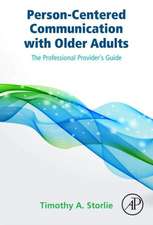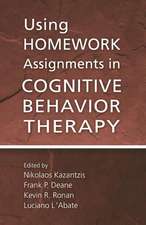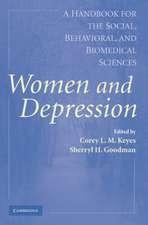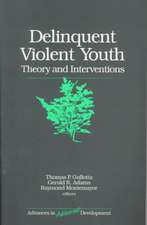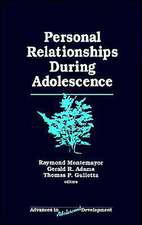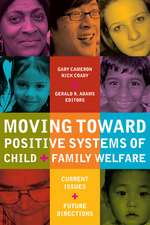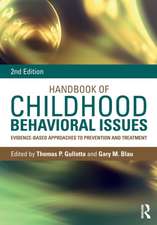Handbook of Adolescent Behavioral Problems: Evidence-Based Approaches to Prevention and Treatment
Editat de Thomas P. Gullotta, Gerald R. Adamsen Limba Engleză Paperback – 13 noi 2008
This volume examines not only the psychological and genetic factors underlying dysfunction, it also explores the critical roles that family members, peers, and the larger community play in an adolescent’s life. It offers current interdisciplinary perspectives on adolescent development, both functional and pathological, and provides coverage that is clear, accessible, and practical on such topics as:
- Major disorders, including depression, anxiety, schizophrenia, ADHD, PTSD, developmental delays, and conduct disorders.
- Behavior problems, such as substance abuse, sexual offenses, teen pregnancy, school failure, gambling, and gang violence.
- Best practices, reviewing what works (i.e., interventions that have been rigorously validated), what might work (i.e., those in need of further study), and what doesn’t work.
- Residential interventions as well as community treatment.
- Risk and resiliency factors.
- Ongoing and emerging pharmaceutical issues.
The Handbook of Adolescent Behavior Problems provides a solid foundation for understanding the adolescent experience and the influence of the family and community as well as much-needed information on the development of evidence-based practices. It is designed to be a one-stop reference for anyone working with adolescents—developmental psychologists, clinical and school psychologists, and education specialists as well as for graduate students in these areas.
Preț: 374.73 lei
Preț vechi: 394.45 lei
-5% Nou
71.71€ • 77.87$ • 60.24£
Carte în stoc
Livrare din stoc 12 martie
Specificații
ISBN-10: 0387887156
Pagini: 665
Dimensiuni: 178 x 254 x 35 mm
Greutate: 1.18 kg
Ediția:2005
Editura: Springer
Colecția Springer
Locul publicării:Boston, MA, United States
Public țintă
Professional/practitionerDescriere
As we enter the new millennium, promoting sound mental health and positive behavior of adolescents has undeniably taken on greater significance than ever before. To that end, more and more research is confirming what many have suspected for years: environment and community surroundings have a major affect on an adolescent’s well-being and overall mental health. And because no single causal agent triggers teenage pathology—and no one-size-fits-all treatment is available—the Handbook of Adolescent Behavior Problems offers a comprehensive and integrative biopsychosocial approach to effective practice.
This volume examines not only the psychological and genetic factors underlying dysfunction, it also explores the critical roles that family members, peers, and the larger community play in an adolescent’s life. It offers current interdisciplinary perspectives on adolescent development, both functional and pathological, and provides coverage that is clear, accessible, and practical on such topics as:
- Major disorders, including depression, anxiety, schizophrenia, ADHD, PTSD, developmental delays, and conduct disorders.
- Behavior problems, such as substance abuse, sexual offenses, teen pregnancy, school failure, gambling, and gang violence.
- Best practices, reviewing what works (i.e., interventions that have been rigorously validated), what might work (i.e., those in need of further study), and what doesn’t work.
- Residential interventions as well as community treatment.
- Risk and resiliency factors.
- Ongoing and emerging pharmaceutical issues.
Each chapter focuses on a specific behavior or disorder and is formatted to help readers quickly locate needed information.
The Handbook of Adolescent Behavior Problems provides a solid foundation for understanding the adolescent experience and the influence of the family and community as well as much-needed information on the development of evidence-based practices. It is designed to be a one-stop reference for anyone working with adolescents—developmental psychologists, clinical and school psychologists, and education specialists as well as for graduate students in these areas.
Cuprins
Section I: Introduction and Overview; Chapter 1: Adolescent Development, Gerald R. Adams; Chapter 2: Understanding Primary Prevention, Thomas P. Gullotta; Chapter 3: Family Influences on Adolescent Development, Gary W. Peterson; Chapter 4: Community Influences on Adolescent Development, Jill Antonishak, Erin L. Sutfin, and N. Dickon Reppucci; Chapter 5: Principles and Approaches to Treatment, Ronald Jay Werner-Wilson and Kathleen M. Morrissey; Chapter 6: Evidence-Based Practices, Thomas L. Sexton, Lynn Gilman, and Christine Johnson-Erickson; Section II: Disorders; Chapter 7: Anxiety Disorders, Patricia A. Graczyk, Sucheta D. Connolly, and Feyza Corapci; Chapter 8: ADHD, Melinda Corwin, Kirti N. Kanitkar, Adam Schwebach, and Miriam Mulsow; Chapter 9: Pediatric Bipolar Disorder, Mani N. Pavuluri, Michael W. Naylor, and John A. Sweeney; Chapter 10: Depression, Clare Roberts and Brian Bishop;Chapter 11: Suicide, John Kalafat; Chapter 12: Obsessive-Compulsive Disorder, Andre P. Bessette; Chapter 13: Oppositional Defiant Disorder and Conduct Disorder, Deborah M. Capaldi and J. Mark Eddy; Chapter 14: Pervasive Developmental Delay, Raymond W. DuCharme and Kathleen A. McGrady; Chapter 15: PTSD, Theresa Kruczek, Jill R. Salsman, and Stephanie Vitanza; Chapter 16: Schizophrenia, Judy McCown; Chapter 17: Eating Disorders, Michael P. Levine and Niva Piran; Chapter 18: Obesity, Jeanne Brooks-Gunn; Section III: Problem Behaviors; Chapter 19: Adolescent Delinquency and Violent Behavior, Daniel J. Flannery, David Hussey, and Eric Jefferis; Chapter 20: Substance Misuse and Abuse, Carl G. Leukefeld, Hope M. Smiley McDonald, William W. Stoops, LaDonya Reed, and Catherine Martin; Chapter 21: Gambling, Tobias Hayer, Mark Griffiths, and Gerhard Meyer; Chapter 22: Adolescent Sex Offenders, Christina M. Camp, Laura F. Salazar, Ralph J. DiClemente, and Gina M. Wingood; Chapter 23: Sibling Incest Offenders, Laura F. Salazar, Christina Camp, Ralph J. DiClemente, and Gina M. Wingood; Chapter 24: Gangs and Gang-Related Behavior, Mark B. Borg, Jr. and Michael R. Dalla; Chapter 25: Homicide, Michael J. Furlong, Vanessa M. Nyborg, and Jill D. Sharkey; Chapter 26: Adolescent Pregnancy, Brent C. Miller , Rayna Sage, and Bryan Winward; Chapter 27: School Failure, Peter W. Dowrick and Natalie Crespo; Chapter 28: Religious Cults, Joseph L. Calles, Jr., Maritza Lagos, Tatyana Kharit, Ahsan Nazeer, Jody Reed, and Suhail Sheikh; Chapter 29, CONCLUSION
Notă biografică
Gerald R. Adams is Professor of Family Relations and Human Development at the University of Guelph. He has been awarded recognition as a Distinguished Professor of Teaching at the University of Guelph, received honors from the American Psychological Association and American Psychological Society, served as the editor of the Journal of Adolescent Research, and was one of three editors for a 10 volume series of Advances in Adolescent Development. He has recently coedited the Blackwell Handbook of Adolescence.
Thomas P. Gullotta is C.E.O. of Child and Family Agency and is a member of the psychology and education departments at Eastern Connecticut State University. He is the senior author of the 4th edition of The Adolescent Experience, co-editor of The Encyclopedia of Primary Prevention and Health Promotion, and is editor emeritus of the Journal of Primary Prevention. He is the senior book series editor for Issues in Children's and Families' Lives . Tom holds editorial appointments on the Journal of Early Adolescence, The Journal of Adolescent Research and the Journal of Educational and Psychological Consultation. Tom was honored in 1999 by the Society for Community Research and Action, Division 27 of the American Psychological Association with their Distinguished Contributions to Practice in Community Psychology Award.
Textul de pe ultima copertă
As we enter the new millennium, promoting sound mental health and positive behavior of adolescents has undeniably taken on greater significance than ever before. To that end, more and more research is confirming what many have suspected for years: environment and community surroundings have a major affect on an adolescent’s well-being and overall mental health. And because no single causal agent triggers teenage pathology—and no one-size-fits-all treatment is available—the Handbook of Adolescent Behavior Problems offers a comprehensive and integrative biopsychosocial approach to effective practice.
This volume examines not only the psychological and genetic factors underlying dysfunction, it also explores the critical roles that family members, peers, and the larger community play in an adolescent’s life. It offers current interdisciplinary perspectives on adolescent development, both functional and pathological, and provides coverage that is clear, accessible, and practical on such topics as:
- Major disorders, including depression, anxiety, schizophrenia, ADHD, PTSD, developmental delays, and conduct disorders.
- Behavior problems, such as substance abuse, sexual offenses, teen pregnancy, school failure, gambling, and gang violence.
- Best practices, reviewing what works (i.e., interventions that have been rigorously validated), what might work (i.e., those in need of further study), and what doesn’t work.
- Residential interventions as well as community treatment.
- Risk and resiliency factors.
- Ongoing and emerging pharmaceutical issues.
Each chapter focuses on a specific behavior or disorder and is formatted to help readers quickly locate needed information.
The Handbook of Adolescent Behavior Problems provides a solid foundation for understanding the adolescent experience and the influence of the family and community as well as much-needed information on the development of evidence-based practices. It is designed to be a one-stop reference for anyone working with adolescents—developmental psychologists, clinical and school psychologists, and education specialists as well as for graduate students in these areas.
Caracteristici
Blends theoretical and scholarly research with practical clinical and practice observations pertinent to the subject area
Provides recommendations for practice improvements and prevention/health promotion

